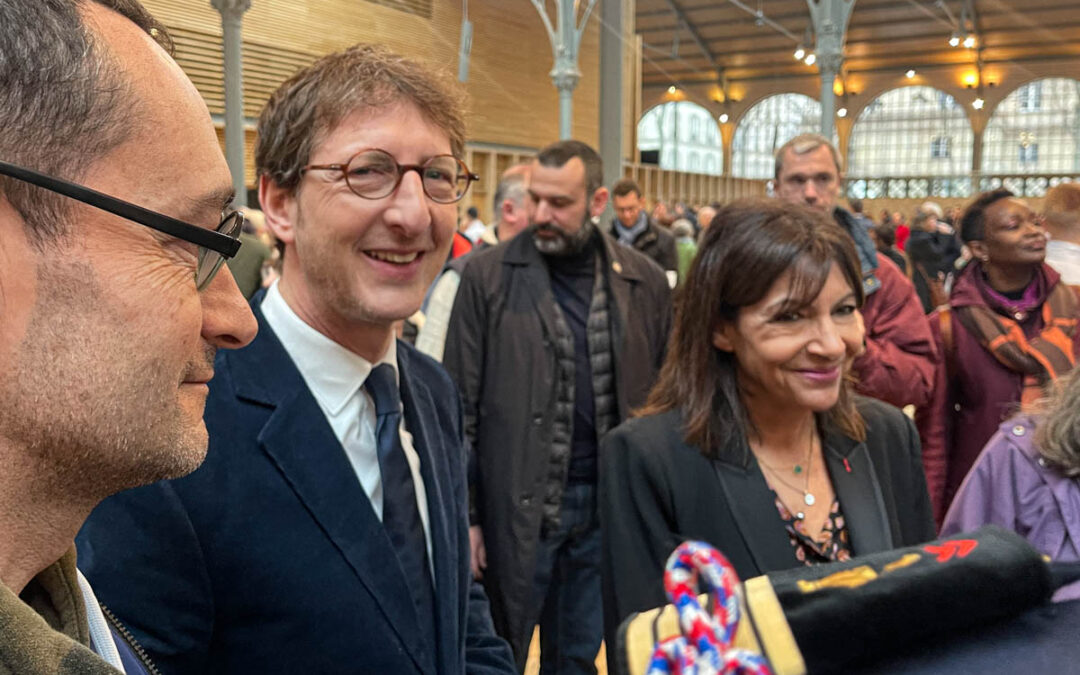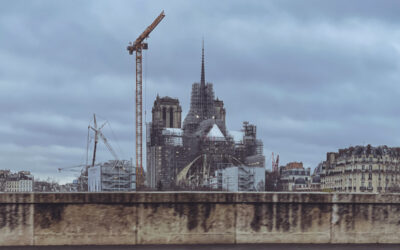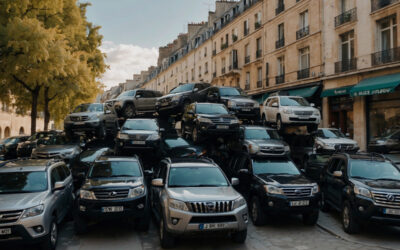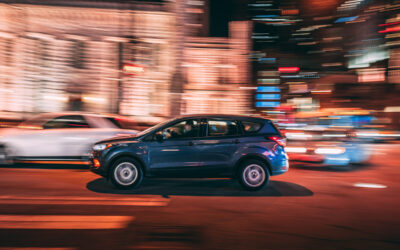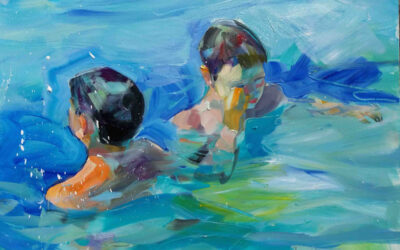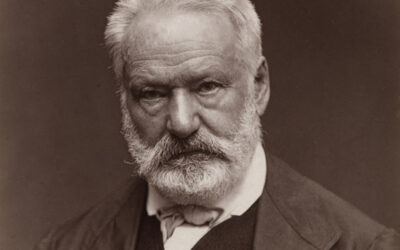Greetings from the mayor of Paris Center, Ariel Weil, in the presence of the mayor of Paris, Anne Hidalgo, on January 14 at Carreau du Temple, photo: Axel G.
On the sidelines of the wish ceremony organized on Saturday January 14, 2023 at Carreau du Temple, the mayor of Paris Center Ariel Weil gave an interview at Marais Mood.
He mentions in particular the future reduction in traffic in the Marais and Paris Center by means of the Limited Traffic Zone (ZTL) which will be implemented gradually over the course of 2023. He also mentions scooters, cones yellow, the 2024 Olympics and the increase in property taxes.
Mayor of the 4th arrondissement from 2017 to 2020, Ariel Weil, 49, has been mayor of Paris Center for two years and six months.
• Le Marais Mood: A new year begins. What to expect in the Marais in 2023?
Ariel Weil : To many things, in many areas: culture, heritage, public space but also mobility. The imminent arrival of the “limited traffic zone” will be one of the main changes. In order to reduce traffic in the center of Paris, reduce noise and pollution, traffic will not be stopped, but limited. This is about eliminating transit traffic so that Paris Center is not used as a shortcut by people who are just passing through the capital.
This involves a series of local measures and a modification of the traffic plan, in the Marais, on the path and elsewhere. The “limited traffic zone”, or ZTL, will be fully effective in 2024.

• Which roads will close to traffic?
Virtually none. There will be no pedestrianization strictly speaking. On the other hand, we are going to eliminate the windfall effects of small through streets, whose layouts date back to the Middle Ages, such as Rue Vieille-du-Temple or Rue des Archives, and where traffic continues to be intense. Certain segments of these streets will be restricted. But only for cars; not for buses and taxis.
Thus, for bus 75 (rue des Archives) or bus 29 (rue des Quatre-fils and other names), traffic flow will be improved. As for local residents and delivery people, they will sometimes have to make small detours to reach certain places. But as traffic will be generally more fluid, it will not be very inconvenient for local residents who, by definition, know the area.
In reality, it will take less time to go around the block tomorrow than to go straight today, because there will be less traffic. These changes concern fifteen to twenty streets in total in the 1st, 2nd, 3rd and 4th arrondissements.
• Aren't you doing it a little too much?
The idea is not to overload the small lanes, as was the case when rue de Rivoli was closed: part of the traffic was then transferred to rue du Roi-de-Sicile.
Rest assured that we always keep the problems of local residents in mind. We have also created a “resident card” which allows residents of the Marais to access rue de Rivoli.
To obtain it, simply go to the town hall. It takes 10 minutes. In fact, if we look at things with hindsight, we see that we are simply correcting fifty years of car-oriented urbanization. Our job is to rebalance things to increase the space available on sidewalks, public squares and in gardens.
• What about scooters in Paris?
The mayor of Paris Anne Hidalgo has just announced the holding of a simplified referendum on Sunday, April 2, in the capital's polling stations (based on electoral files). Parisians will vote on whether or not to maintain self-service scooters in the capital.
My point of view is that scooters do not provide any real ecological benefit. They are not used by people who give up the car but by those who give up walking or public transport.
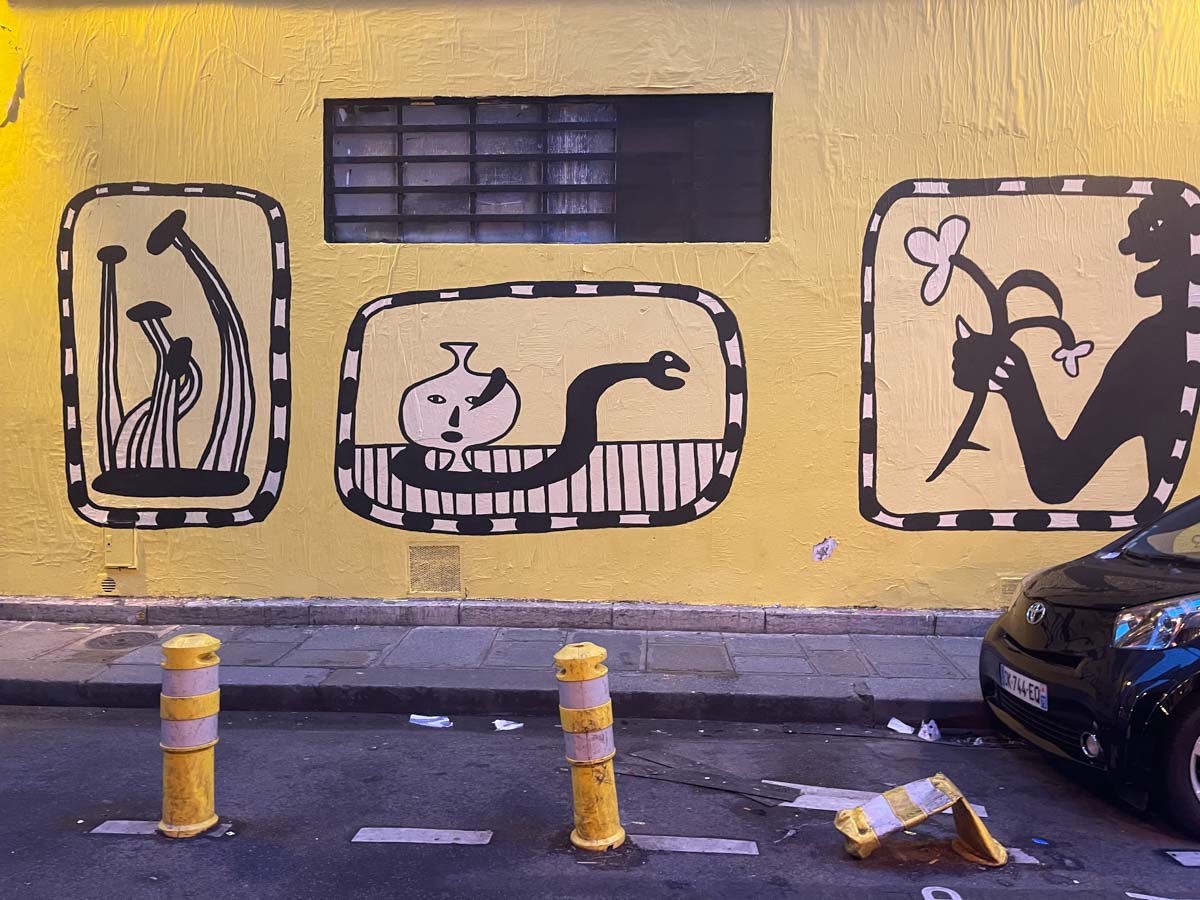
Yellow plots on rue Charlot
• And the yellow studs, which are really ugly?
It's finish ! The last ones, which are located on rue Charlot, will disappear. We are replacing them with traditional Parisian furniture. And this, in a lasting manner, like what was done on rue Sainte-Croix de la Bretonnerie, where we gained an additional 1,20 meters for pedestrians.
• Let’s talk energy sobriety. Why is the town hall lit all night?
This is not the case. It is not lit all night. On the contrary, the municipality saves electricity. We have adopted energy conservation measures, such as lowering temperatures in public buildings or water in swimming pools.
All municipal agents have also been provided with sleeveless down jackets that they can wear in their workplace.
Concerning public lighting, it is complicated to reduce it because it also fulfills a security function. Turning off the street lights would make the streets more dangerous, more worrying.
In reality, the public sector is making quite a bit of effort. The challenge now is to ensure that the private sector does the same, particularly through energy renovation in private condominiums.
The city, the region and the State have put in place interesting incentive measures, which include property tax reductions: owners who improve their thermal insulation will thus be able to deduct their expenses from their tax declaration.
• Property taxes are increasing by about 40% this year: that's a lot, especially for retirees.
Yes, but this is accompanied by a certain number of exemption measures, in particular for people over 65 and “poor owners”, that is to say retired owners who live on social minimums. . Other citizens benefit from discounts if they carry out thermal insulation work at home.
• The 2024 Olympics are approaching. How will this impact the lives of the inhabitants of the Marais?
First, an important clarification: these are the “JOPs”, or the Olympic and Paralympic Games of Paris 2024. Our district is concerned in three ways.
First, the Carreau du Temple will serve as a press center for “unaccredited” journalists, that is to say those who come from all over the world to cover the event outside of the sporting events themselves. These are those who will report on Paris and France. This will create some animation.
Secondly, the opening ceremony, directed by Rouen choreographer Thomas Jolly, will take place on the Seine, therefore on the edge of the Marais and Paris Center, along the 4th and 1st arrondissements. It will be a great moment.
Finally, thirdly, the marathon route will cross Paris Center.
But the real issue, beyond the month and a half of high-level sport, will be the legacy left by the JOP. It is a question of ensuring that all the investments made are sustainable and benefit Paris. Because we are all committed to making the capital more beautiful. However, we are already observing how the organization of the Games acts as an accelerator of change and allows us – a bit like the Covid crisis – to accomplish more quickly what we intended to do anyway.
Thus, for a whole series of projects that needed to be undertaken, the prefecture is already issuing its authorizations at a faster pace. It's very positive. The Olympic and Paralympic Games will generate incredible energy.
19.01.23
NEWS, IT'S THIS WAY
Notre-Dame: dismantling of the scaffolding has begun
The gigantic repair project at Notre-Dame de Paris cathedral is coming to an end. The dismantling of the spire scaffolding has begun. It is visible again with, at its top, a rooster which sits in majesty. In ten months, visitors will be able to return to the places whose reopening is planned...
Vote on SUVs: The results in Paris-Centre
Paris voted against SUVs. But only 6% of residents went to the polls. Of the 1 Parisians registered, 374 took part in the ballot. With 532% of votes in favor, the majority expressed their desire to tax these behemoths of the Parisian streets.
For or against SUVs vote on February 4, 2024
In the debate on traffic in Paris, the question of SUVs gives rise to lively discussions. Some advocate a ban because of their environmental impact and their congestion in the city.
NOW ON THE MOOD MARSH
With the artist Malacarne, we dive into the Big Blue
Why go to the sea when you can find it in the Marais, at the Menouar gallery, rue du Parc-Royal? Here, we dive directly into the Big Blue with the work of Malacarne, a post-impressionist artist of reflection, light and water whose brush caresses the surface of the sea.
Victor Hugo, the writer with a thousand talents
Born in 1802, Victor Hugo became a social writer, a playwright, a poet, a novelist and a romantic designer. Nicknamed the man-ocean then the man-century, he is a political figure and a committed intellectual. He found success with Notre-Dame-de-Paris in 1831 and with Les Misérables in 1862.
The best tattoo parlors in Marais
Tattooing, an age-old practice, has long been the prerogative of convicts, dock workers, the underworld and sailors. Although it has become democratized, now affecting all profiles and concerning one in five French people, including 16% women compared to 10% men, it still remains taboo due to its definitive and transgressive nature.

